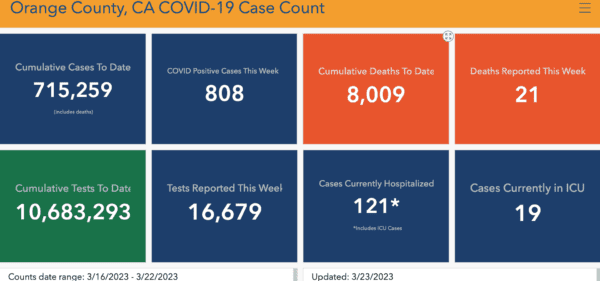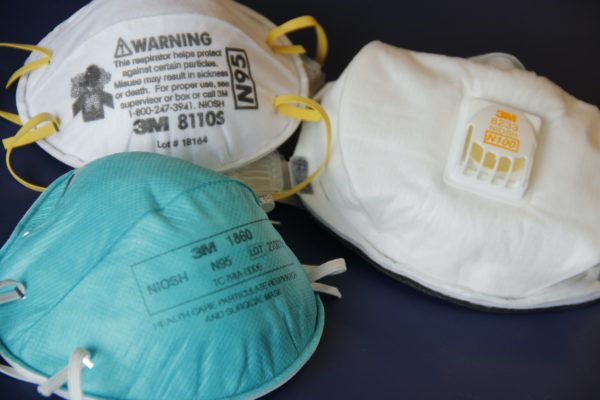The state’s COVID-19 state of emergency may have ended, but a prominent UC Irvine epidemiologist and the county’s chief health officer advised residents Friday to stay on guard.
Dr. Regina Chinsio-Kwong updated the county’s order on Friday, relaxing some of the requirements that had been in place during the pandemic. The federal public health emergency is scheduled to end on May 11.
Chinsio-Kwong’s has modified the vaccine requirements for health care, jails and adult care facilities to strongly recommended. Some health care providers and suppliers are still required to be vaccinated.
Chinsio-Kwong also strongly recommended face coverings for health care establishments, jails and facilities for the elderly, the homeless and long-term care patients. Face masks are also strongly recommended for visitors, residents and staff at skilled nursing facilities if there is an outbreak.
Those infected with the virus are no longer ordered to isolate for five days, but it remains strongly recommended. It is OK to discontinue isolating after five days if symptoms have improved and there is no fever without medication to reduce a fever, but wearing a face mask is strongly recommended for those recuperating for 10 days.
Chinsio-Kwong also said studies continue to show that the bivalent booster shots protect against serious illness as well as long COVID.
Andrew Noymer, a UC Irvine professor of population health and disease prevention, told City News Service the key metric he is keeping an eye on is the number of intensive care unit patients with the virus because public testing data is so scant it is difficult to gauge infection rates.
“We’re in the new dark ages of COVID data because nobody’s testing, etc.,” Noymer said. Or, if they are, it’s being done privately at home and the results go unreported.
“That’s why I’m looking at the ICU number right now,” he said. “But it’s moving in the right direction, but painfully slowly.”
The number of intensive care unit patients with the virus has remained relatively stable so far this year, but it’s not the same people in the hospital as it is logged each week in the county, Noymer said.
“Some go from the ICU to the funeral parlor,” he said. “It’s not the same 19 people each week. But, to be fair, some people leave the ICU and go back home too.”
The number of patients hospitalized with COVID-19 infections stood at 121 as of Wednesday, the OC Health Care Agency reported on Thursday. That was down from 147 on March 15. The number of ICU patients dipped from 21 to 19.
The county logged 21 more fatalities, boosting the overall death toll to 8,009.
Of those fatalities, 15 occurred this month, boosting the death toll so far to 22. Five of the fatalities occurred in February, increasing last month’s death toll to 49.
Another fatality happened in January, increasing that month’s death toll to 119.
“COVID is a significant cause of death for people over 65,” Noymer said. “That’s something people need to on-board.”
Overall, Noymer said he was “cautiously optimistic” about the trends.
“It’s clear COVID is on the dip and continues to be,” he said. “We’re very happy about it. But people should be aware there’s a new disease out there called COVID and it’s out there. That doesn’t mean you can’t book a dinner party, but it also doesn’t mean COVID has disappeared. If you had told me 36 months ago there would permanently be 19 people in the ICU I think you would have called me overly pessimistic.”
Of those hospitalized in the county, 61.4% are unvaccinated or partly vaccinated. The ICU patients are 62.4% partly vaccinated or unvaccinated.
The number of residents fully vaccinated increased from 2,369,209 to 2,369,627. The number of residents who have received at least one dose is 226,727. The number of booster shots administered increased from 1,453,380 to 1,454,356.
The number of children up to 4 years old who have received at least one dose inched up from 18,995 to 19,072 with 12,294 fully vaccinated. Just 6.6% of the county’s population in the age group is fully vaccinated.
For 5- to 11-year-old children, 97,614 are fully vaccinated, about 36.8% of the age group. In the 12-to-17 age group, 69.7% are fully vaccinated.
The test positivity rate rose went from 6.2% to 5.8% and decreased from 5.5% to 4.8% in the health equity quartile, which measures the communities hardest hit by the pandemic.
The positivity rate for those fully vaccinated with a booster, which was 4 on March 5, went to 4.2 on March 12. For those vaccinated with no booster, the rate went from 2.7 to 2.5. For those not vaccinated the rate went from 9.7 to 8.4.
The daily case rate per 100,000 went from 4.2 to 3.9 on a seven-day average with a seven-day lag and from 4.4 to 4 in the adjusted daily case rate per 100,000 on a seven-day average with a seven-day lag.
The county logged 808 new cases of COVID-19, increasing the total since the start of the pandemic to 715,259.
The OCHCA reports COVID-19 data every Thursday.







